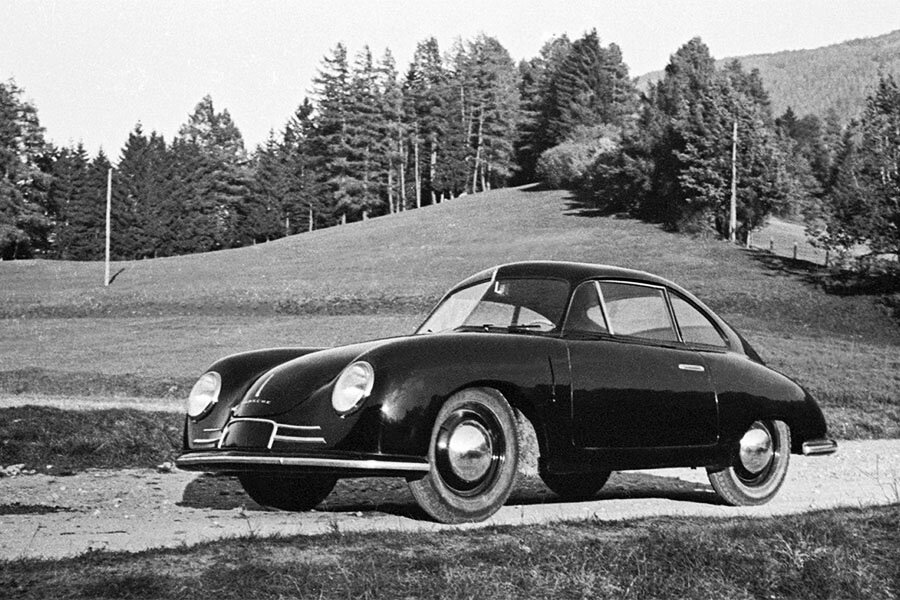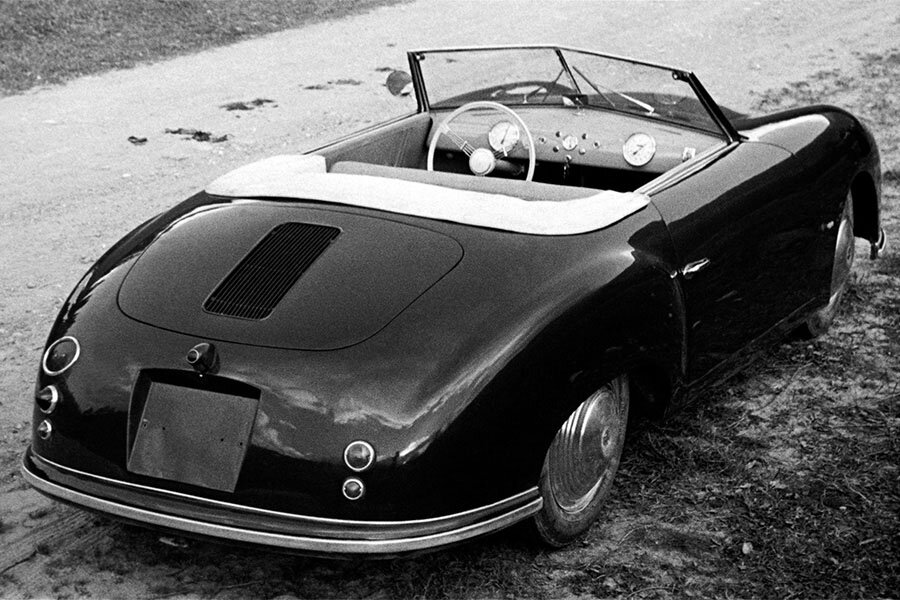Guide: Porsche 356/2 Gmund - a Historical & Technical Appraisal
/BACKGROUND
Ferry Porsche’s first chassis drawings for the 356 were laid down in July 1947. At this point, his father, Ferdinand, and brother-in-law, Anton Piech, were still imprisoned for war crimes.
In December 1945, the French authorities had prosecuted all three men for the employment of over 300 forced labourers at their Zuffenhausen factory during World War 2.
Ferry Porsche had been released after six months while his father and Anton Piech remained in custody.
In the absence of his father and brother-in-law, Ferry Porsche did his best to keep the company in business.
The firm’s original Zuffenhausen plant was occupied by the American army which meant operations continued at a remote converted sawmill in Gmund, Austria. The firm had temporarily relocated to Gmund in 1944 as increasing Allied air raids made life in Stuttgart untenable. Management, the design department and parts of its production had all moved away.
After hostilities ended, Porsche’s Zuffenhausen factory had been taken over by the Americans and, with no prospect of its imminent return, a move back to Germany was not initially on the cards.
All kinds of machine repairs were carried out in Gmund just to stay afloat. However, when a design contract for the Cisitalia 360 Grand Prix car came through, the Porsche family were able to make a one million Franc bail payment to the French authorities.
In late 1947, Ferdinand Porsche and Anton Piech were released from jail.
Even before the 356/1 had been completed (in June 1948), it was obvious the car’s spaceframe chassis was too labour intensive for volume production. Furthermore, its mid-engine layout was deemed impractical for everyday use.
Ferry Porsche therefore set about designing a new car and, in May 1948 (one month before the 356/1 was finished), blueprints for the 356/2 in both Coupe and Cabriolet body styles were completed.
Despite its flaws, the 356/1 nevertheless served as a useful marketing tool while the first 356/2s were readied.
One enthusiastic supporter was Rupprecht von Senger, a car dealer and advertising agency owner from Zurich. Von Senger had previously been in contact with Porsche on another matter and, when he saw the newly completed 356/1, he ordered five of the forthcoming 356/2s.
Von Senger’s involvement was crucial. In return for paying up front and supplying Porsche with the raw materials required (lightweight metals were extremely hard to get hold of in Austria but not in Switzerland), von Senger and his business partner, Bernhard Blank, were given the contract for Swiss Porsche imports.
Meanwhile, to secure their Austrian sales permit, Porsche had to promise the government in Vienna that the vehicles being made from this precious commodity would be sold abroad. This would provided the nation with much-needed foreign currency.
CHASSIS
Despite some visual similarities, the 356/2 was very different from the 356/1.
Instead of a tubular spaceframe, the 356/2 adopted a welded steel unitary body / chassis with integrated floorpan. Far quicker and cheaper to build, the floorpan roughly corresponded to that of the Volkswagen Beetle but, in reality, had many detail changes.
Box-section sills, a central tunnel and revised bulkheads meant it was considerably stiffer while the engine and transaxle were turned through 180°. New bulkheads gave the chassis sufficient strength that the Cabriolet variant needed no additional reinforcement.
Compared to the 356/1, the 356/2’s wheelbase was shortened by 50mm to 2100mm.
Like the Volkswagen, fully independent suspension was via transverse torsion bars and trailing arms with additional swing axles at the rear.
As the engine was now mounted in the back (behind the transaxle as per the Volkswagen), it allowed the rear trailing arms to operate as intended after they had been reversed on the 356/1.
Hydraulic shock absorbers were supplied by Boge.
Volkswagen’s cable-operated drum brakes were installed on a handful of early cars but this arrangement was soon switched to a hydraulic system supplied by Lockheed of England. The drums had a 230mm diameter all round (40mm thick at the front and 30mm at the rear) with a twin-leading-shoe arrangement up front and single trailing shoe at the back.
Steel 3 x 16-inch wheels came with domed hubcaps and 5 x 16-inch tyres.
A spare wheel was mounted underneath the front lid ahead of the 50-litre fuel tank.
ENGINE / TRANSMISSION
The 356/2 came with an evolution of the Porsche-tuned Volkswagen engine as fitted to the 356/1.
An air-cooled horizontally opposed Flat 4 with cast iron cylinders and an aluminium alloy block and head, this Type 369 overhead valve pushrod unit displaced 1131cc thanks to a bore and stroke of 75mm and 64mm respectively.
Like the 356/1, compression was increased from Volkswagen’s standard ratio of 5.8:1 to 7.0:1.
The original Solex 26 VFI downdraught carburettor fitted to the 356/1 was replaced with a VFJ component.
The biggest issue that restricted Volkswagen’s engine was its ability to breathe. In order to further enlarge the valves, Porsche canted the exhaust valves outwards at 32° on the horizontal plane. This also smoothed the flow from the previously sharp angle in the exhaust port and afforded better cooling of the head.
Dual valve springs enabled the engine to run at higher revs and domed pistons ensured it could handle the increased compression ratio.
Peak power rose from 35bhp at 4000rpm (on the 356/1) to 40bhp at 4200rpm. The torque rating was unchanged with 51lb-ft at 2600rpm.
After the first handful of examples had been built, Porsche made a bore reduction of 1.5mm to bring the displacement down to 1086cc which enabled the car to compete in the popular under 1100cc motor sport class. Peak power for these engines came in 200rpm higher (40bhp at 4200rpm).
Transmission was via a four-speed non-synchromesh Volkswagen gearbox positioned ahead of the engine.
BODYWORK
The first rolling chassis was ready by July 1948 and underwent an intensive test programme prior to being fitted with a body.
The 356/2 was offered in Coupe and Cabriolet body styles with both variants designed by Porsche employee, Erwin Komenda.
Each car had an aluminium shell with steel doors, all of which was painstakingly formed by hand.
Coupes were manufactured by Porsche in Gmund while the Cabriolets were mostly assembled on already completed chassis by Beutler in Thun, Switzerland. A small number of Cabriolets were also finished by Austro-Tata and Keibl, both of whom were based in Vienna.
Unlike the Coupes, Cabriolets had pronounced curvature styled into the rear fender line.
Like all the latest automotive designs, the 356/2 had its wings and headlights fully integrated with the rest of the body. The slippery shape of both body styles proved extremely efficient and played a large part in these modestly powered machines being able to exceed 80mph.
Early cars came with front quarterlights and semaphore indicators but these were soon dropped in favour of single-piece side windows and indicators mounted underneath the headlights.
A split front windscreen was fitted to all cars.
The Volkswagen-style up-hinged engine cover had a longitudinal intake and protective grille which fed air to the cooling fan.
Coupes were typically accessorised with decorative chrome strips alongside the front licence plate surround but these were not generally fitted to Cabriolets.
Aside from Porsche lettering below a teardrop trim element on the nose, there was little in the way of body decoration.
Wraparound aluminium bumpers were fitted close to the body and sometimes equipped with overriders.
INTERIOR
At this stage, Porsche cockpits were still pretty spartan and not all the cars were finished to an identical specification.
Common themes were a large three-spoke faux ivory steering wheel and painted metal dash.
Instrumentation generally consisted of a speedometer directly behind the steering wheel and a clock mounted on the glovebox. Some of the Beutler Cabriolets (which were generally finished to the highest possible specification) also came with a tachometer.
A bench seat was the norm but sometimes, individual seats were fitted along with a pair of smaller seats in the rear. Seats, door panels and sidewalls were usually upholstered in leatherette but a few cars did come with fabric instead.
Ergonomically, everything was well laid out, visibility was very good and there was plenty of space for tall drivers.
WEIGHT / PERFORMANCE
Weight was typically around 615kg and, thanks to the car’s aerodynamic styling, a top speed of around 85mph was possible.
Just as importantly in war-ravaged Europe, the 356/2 was capable of returning up to 30mpg.
LAUNCH
Porsche published their first promotional material for the 356/2 in the summer of 1948.
Rupprecht von Senger and Bernhard Blank then displayed a bare chassis at their Kreuzgarage in Zurich ahead of the first completed car’s debut appearance at the Geneva Motor Show in March 1949.
Porsche had two vehicles on their stand: a Coupe (chassis 356/2-001) priced at CHF 15,000 and one of Beutler’s Cabriolets (chassis 356/2-002) priced at CHF 17,000.
SUBSEQUENT DEVELOPMENTS
In September 1949, Ferry Porsche signed a 20 year agreement with Volkswagen’s General Manager, Heinz Nordhoff, that saw the Porsche company retained for design consultation. In return, Porsche got access to engineering services and parts supply and their cars could be serviced through the official Volkswagen network. Porsche also took a small royalty payment from every Volkswagen sold.
However, Porsche were still leading a rather precarious existence in Gmund where space was severely limited and production conditions were difficult; it was clear the old sawmill would never allow sufficient volume for the car building side of the business to become profitable.
RETURN TO GERMANY
As the Porsche family’s Zuffenhausen plant was still occupied by the Americans, an alternative solution had found if the company was to return to Germany.
The Reutter coachbuilding company was also based in Zuffenhausen and had a reputation as the best in the business. In November 1949, Porsche struck a deal with Reutter for 500 bodies and, as part of the agreement, Porsche leased 5000 sq ft of warehouse space from Reutter for final assembly of their cars.
The first Porsche completed in Stuttgart was finished in March 1950.
Porsche’s engineering and administrative staff stayed in Gmund until December 1950, by which time an additional 1100 sq ft facility had been purchased right next to Reutter.
The last cars to emerge from the old sawmill in Gmund were completed in early 1951.
Total Austrian production for the 356/2 was 44 Coupes and 8 Cabriolets.
Text copyright: Supercar Nostalgia
Photo copyright: Porsche - https://www.porsche.com


































